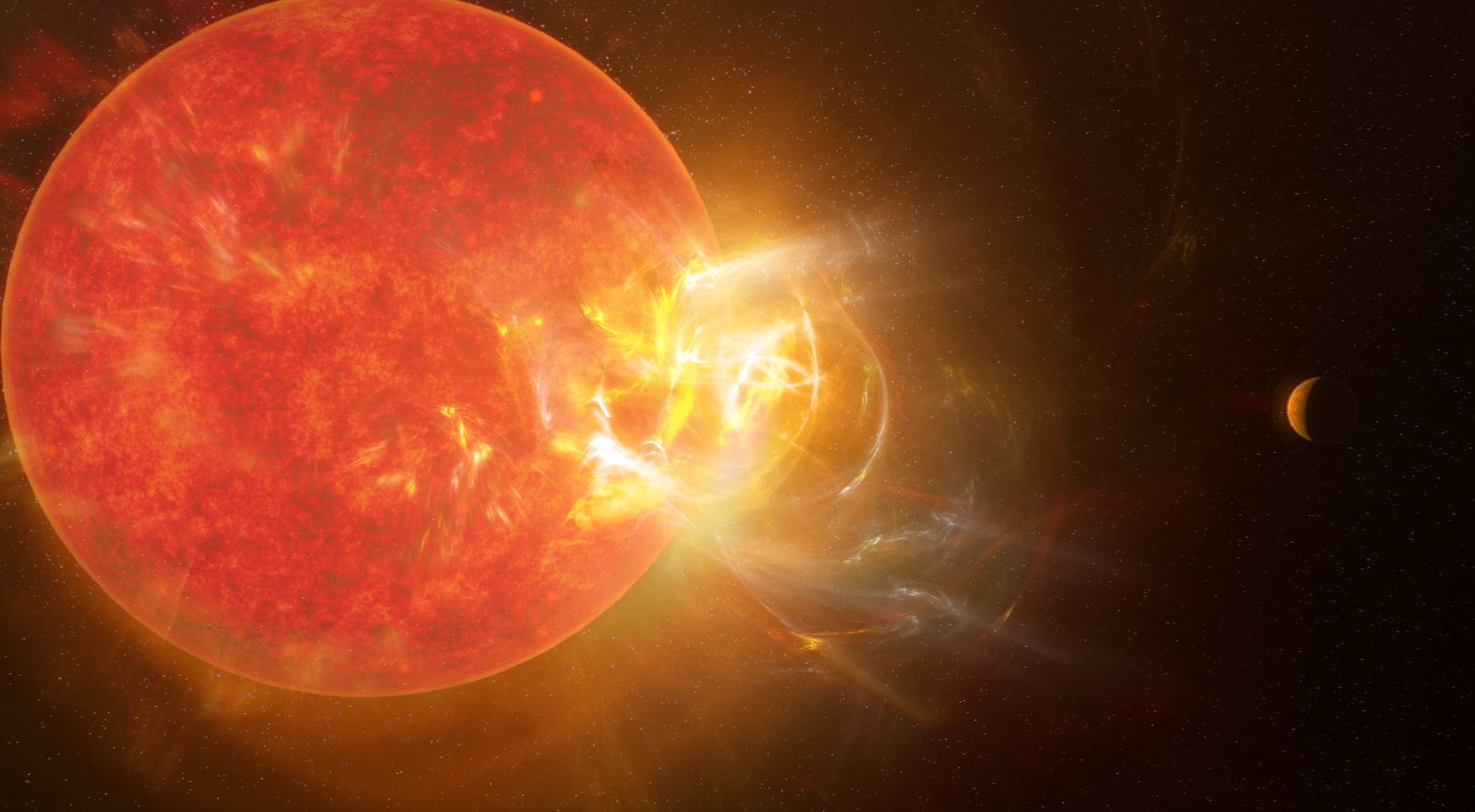Proxima Centauri — the nearest star to our own — has produced one of the most powerful flares on record. The observation is potential evidence that red dwarfs, though plentiful, are inhospitable to life.
It lasted for just seven seconds.
But during those precious seven seconds, the flare was observed by no less than nine observatories, some on the ground and some in space. It was during this short amount of time that ultraviolet radiation from this star suddenly jumped, becoming roughly 14,000 times more intense than normal.
The enormous flare occurred on Proxima Centauri, a red dwarf located approximately four-light years from Earth. But while this star is the closest to our own, it scarcely resembles our stellar companion, as red dwarfs are lightweight, faint, and very cranky (as a fun aside, our Sun is categorised as a G-type yellow-dwarf main sequence star). Proxima Centauri has one-eighth the mass of our Sun, but like other red dwarfs, it’s very active, producing a steady succession of powerful flares.
New research published in The Astrophysical Journal Letters documents this extreme flaring event, which now “ranks as one of the most violent seen on a solitary star anywhere in the galaxy,” according to a press release prepared by Arizona State University. Astronomer Meredith MacGregor from the University of Colorado-Boulder led the new study.
“This is a very interesting piece of work, and the new observations are fascinating,” James Owen, a theoretical astrophysicist at Imperial College London and an expert on red dwarfs, said in an email.

MacGregor’s team observed Proxima Centauri across several months in 2019, collecting 40 hours of data. A total of nine observatories were used, including the Hubble Space Telescope, the Atacama Large Millimetre Array (ALMA), NASA’s Transiting Exoplanet Survey Satellite (TESS), and the Australian Square Kilometre Array Pathfinder (ASKAP). The short duration flare — a powerful burst of radiation — was detected in ultraviolet light on May 1, 2019. The use of multiple observatories allowed the team to study the flaring event from multiple vantage points.
“It reminds me of the old parable about the blind men and an elephant, where different people observe small parts of the elephant and conclude that one part is a snake, another a wall, another a tree,” Evgenya Shkolnik, a co-author of the study and an astronomer as ASU, said in the press release. “Only when they look at all the angles together, do they finally understand it is an elephant. This mutliwavelength flare from Proxima Centauri is our first snapshot of the whole elephant.”
The flare didn’t produce much visible light, but the astronomers detected the surge in both ultraviolet and radio radiation. This marks the first time that radio radiation, also known as millimetre radiation, has ever been observed in a stellar flare. It’s an important new clue — one that could offer new insights into red dwarfs and their exaggerated levels of activity.
This finding also carries implications for astrobiology. Upwards of three-quarters of all stars in the Milky Way are red dwarfs, but if this sort of thing is commonplace, that could be a grim sign for galactic habitability in general (well, in a manner of speaking; approximately 100 billion to 400 billion stars exist in the Milky Way, so that still leaves us with plenty of non-red-dwarf options). The observed flare on Proxima Centauri was 100 times more powerful than any flare measured on our Sun. These outbursts can rip away atmospheres, including the ozone layer, and blast organisms with deadly radiation. The flare on May 1 may have been the biggest detected, but it was hardly the only one seen in the 40-hour dataset. These findings are further indication that red dwarfs, also known as M-dwarf stars, are extremely active, and as a consequence, unfriendly to life.
This is relevant to Proxima Centauri, as it hosts a planet within its habitable zone.
“Exoplanets, particularly those that reside at distances where liquid water could be present, are particularly common around M-dwarf stars, and we’re on the cusp of being able to search their atmospheres for the signs of life,” explained Owen, who wasn’t involved in the new study.
As to what a “habitable zone” means in a red dwarf system, however, is an open question. As McGregor points out in the press release, “Proxima Centauri’s planets are getting hit by something like this not once in a century, but at least once a day if not several times a day.”
There is a possible bright side to all this, in that radiation can trigger chemical reactions that form the molecular building blocks of life. It’s not known, however, if the effects of these flares are more helpful or deleterious when it comes to the habitability of red dwarf systems.
“The balance between the destructive and beneficial nature depends on how the energy is distributed as a function of wavelength (which this study provides in detail), how frequently they occur, and how they interact with the planet,” said Owen. “The last two still remain open questions.”
So scientists are not quite ready to declare the habitable zones of red dwarf systems as being sterile wastelands. It’s hard to imagine life on a planet that’s continually bombarded by powerful radiation, but even on Earth we have examples of microbial life that seem to shrug aside the effects of radiation. As for complex life existing in red dwarf systems, that’s another issue entirely, though tardigrades provide yet another striking example of organismal resilience.
More research is needed for us to be certain, but one thing is becoming increasingly clear: The conditions around red dwarfs are extreme, and any life within these systems would have to be equally extreme.
